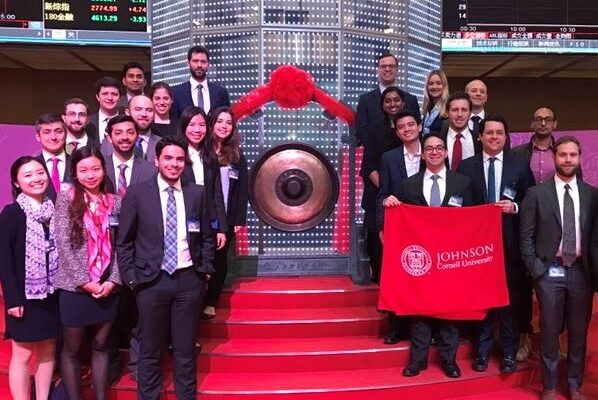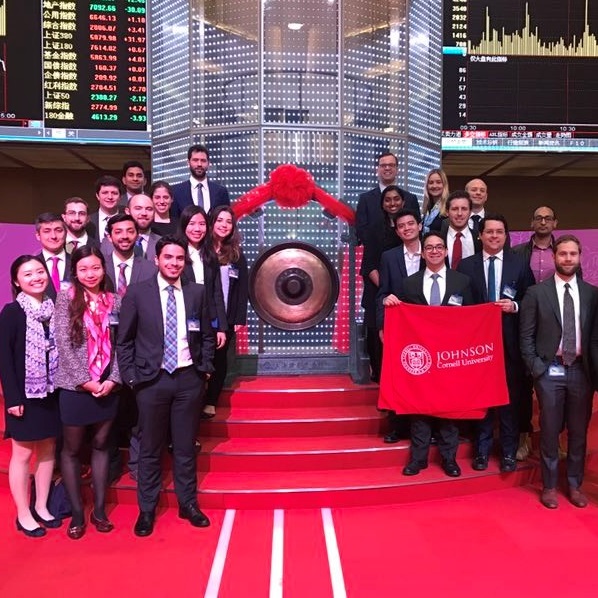China: A sneak peek at the future

China is taking advantage of the accelerated growth of its economy. Contrary to other emerging markets, China has managed to disburse growth to large pools of its population, increased disposable income of a previously impoverished population.

by German Peralta, MBA ’17
Thanks to the Cunningham Fund, a fund part of the Emerging Markets Institute of the Johnson College of Business at Cornell University, I was able to participate on my first international study trip to China. This trip allowed me and my classmates to visit a soon to be non-emerging market and understand the cultural and business nature of the well-known Chinese economy boom. We visited companies in Beijing, Hangzhou and Shanghai, enjoyed local food and met with Johnson alumni. This eye-opening experience allowed me to understand how the scale of China and its increased middle class growth will enable the most populous country in the world to become the largest GDP economy in the world by 2030[1]. Chinese companies focus on monetizing its population while the growing public and private equity market deregulation enables funding that will allow its sustainable growth. We visited private companies with accelerated growth as well as China´s biggest private equity fund and the Shanghai stock exchange. These experiences with the added cultural value of the trip allowed me to understand China and have an idea of what to expect in the upcoming years.
During our trip we visited VIP Kid in Beijing, Alibaba in Hangzhou and CTrip in Shanghai. These companies have the same common revenue driver:increased middle class and disposable income. VIP Kid is a tech company that has created a business out of teaching English to children in China using certified teachers that work from home in the US. The company has quadrupled in size in the past year and currently generates revenues in excess of ¥120M(~$40M). Offering a $50 an hour service (more than half of the Chinese minimum wage), the company takes advantage of a language gap in the market and an increased disposable income for upper middle class families in China. Alibaba is now one of the largest tech corporations in the world that has managed to merge an Amazon, Ebay, Whatsapp, Venmo, Tinder, Uber and Apple Pay into one. In their silicone-valley-like campus in Hangzhou we were able to talk to employees and understand that given the size of the country´s growth has enabled them to create incentives for employees to innovate within Alibaba instead of venturing outside the company to start separate businesses. This allows them to get massive funding and the strong equity compensation enables them to have ownership as well. Finally, in CTrip (the Chinese $20Bn Expedia-like travel agency) has managed to take advantage of the growing travel industry in China and the fact that English is very uncommon. They operate as a one stop shop for Chinese travelers to anywhere from domestic travel to visiting Machu Picchu in South America. In their massive Shanghai business complex their offices seem like a SoHo startup that will certainly overtake its American rivals soon.
From the equity funding side, the group visited JD Capital in Beijing and the Chinese Stock Exchange in Shanghai. At JD Capital, we learned that fundraising is very easy and their cultural/language advantage to large global American or European competitors, allows them to invest in mid-market companies that are thriving from the economic boom. Over the past years, they’ve managed to average a 30% IRR with an average of 6 years holding period. This is materialized with zero leverage given the debt restrictions imposed by the government. Major exits are through the public markets and the fact that the still small stock exchange in China allows multiple expansion at astronomically high EBITDA multiples. Investors are dying to invest, however, JD carefully picks their deals given the still controlled IPO dynamics that take well over a year.We also visited the Shanghai stock exchange, where we learned that even though the IPO process is long, they currently have over 60 companies waiting to get listed and the government officials face pressure to expedite the approval process. Even if we consider the current time to IPO, the Shanghai stock market should double in size in the next year. In our visit, we also learned over 90%of the investors on the Stock Exchange are local Chinese individuals that are starting to invest their savings in the public markets. This is an indicator that with the growth of the still small middle class in China, public markets should continue to grow and that growth (or returns) will come back to the general public.
In summary, we can see that China is taking advantage of the accelerated growth of its economy. Contrary to other emerging markets,China has managed to disburse growth to large pools of its population, increased disposable income of a previously impoverished population. Its spotless clean, modern cities and massive luxury malls show a country that is growing and will continue to grow given its conditions. The question is how can similar economies (like Brazil or Russia) learn from them to accelerate the global economy from internal growth.
[1]World bank projections xxxxx
